On the surface, Enterprise Service Bus technology (ESB) and Integration Platform as a Service (iPaaS) appear the same. Both help integrate systems and applications. But when you scratch beneath the surface, the differences become clear.
While both ESB and iPaaS are the bridge between two applications, their scalability, flexibility, and intricacy of integration differ entirely. So, when you sit down and compare ESB vs. iPaaS, who wins? That’s what we dissect today.
What is ESB?
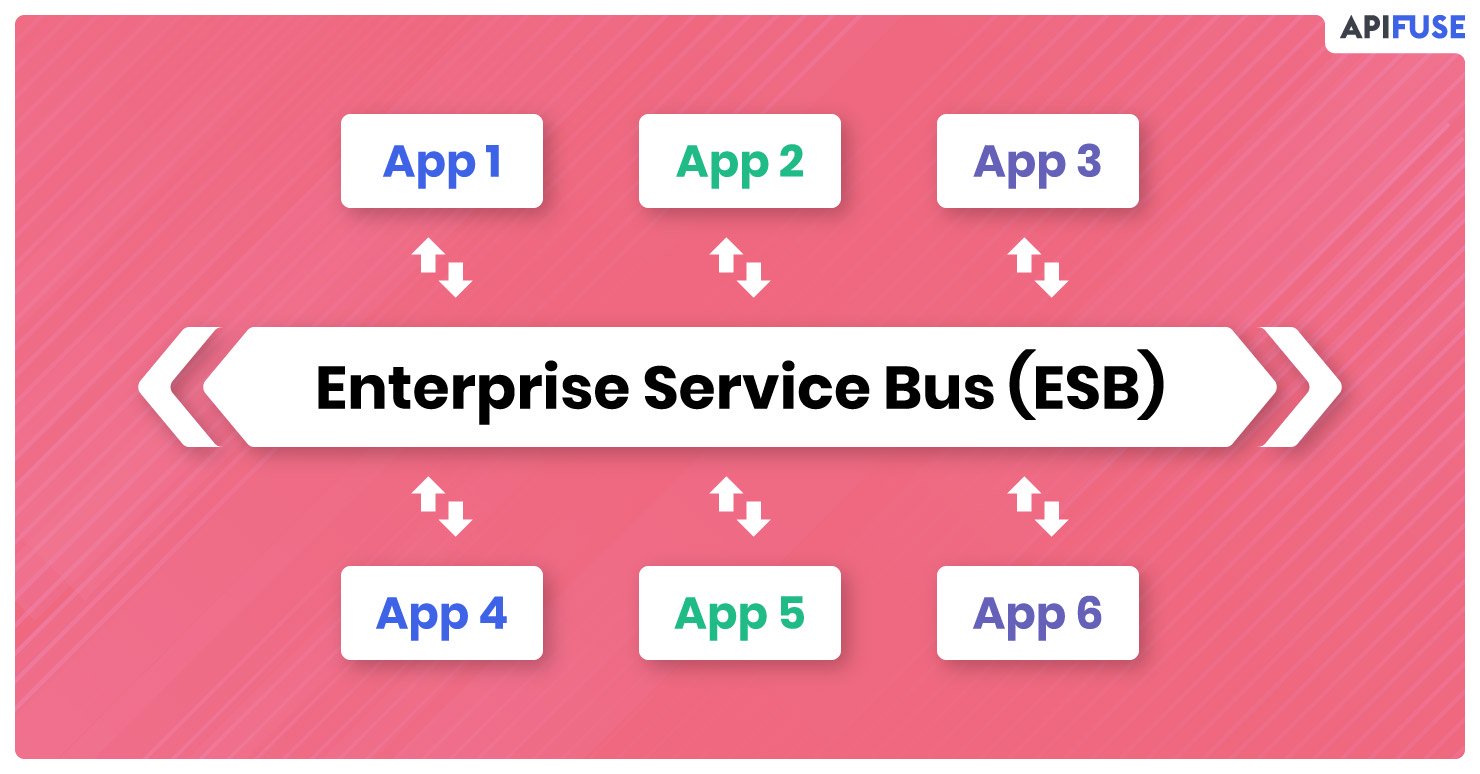
Long before cloud services became a thing, large organizations needed something to handle their integration requirements. So, ESB was born. Fundamentally an architecture, it helped them manage high-volume and often complex traffic within their ecosystem.
Enterprise Service Bus is a set of rules and principles for integrating applications. The tenet of the architecture model is to put a communication bus between applications. This allows them to talk to each other. Think of ESB as a switchboard that reroutes messages between two points.
The positive of this bus-like structure is that each system is decoupled from the other. Therefore, an application can communicate with software (or vice versa) without dependency.
Then both SaaS and cloud environments exploded. It meant integration demands amplified not just for large enterprises but also smaller businesses. And ESB was not suited for the latter for a whole host of reasons, the biggest being the increasing dependence on IT users.
As a response to these data and application integration needs, iPaaS rose.
What is iPaaS?
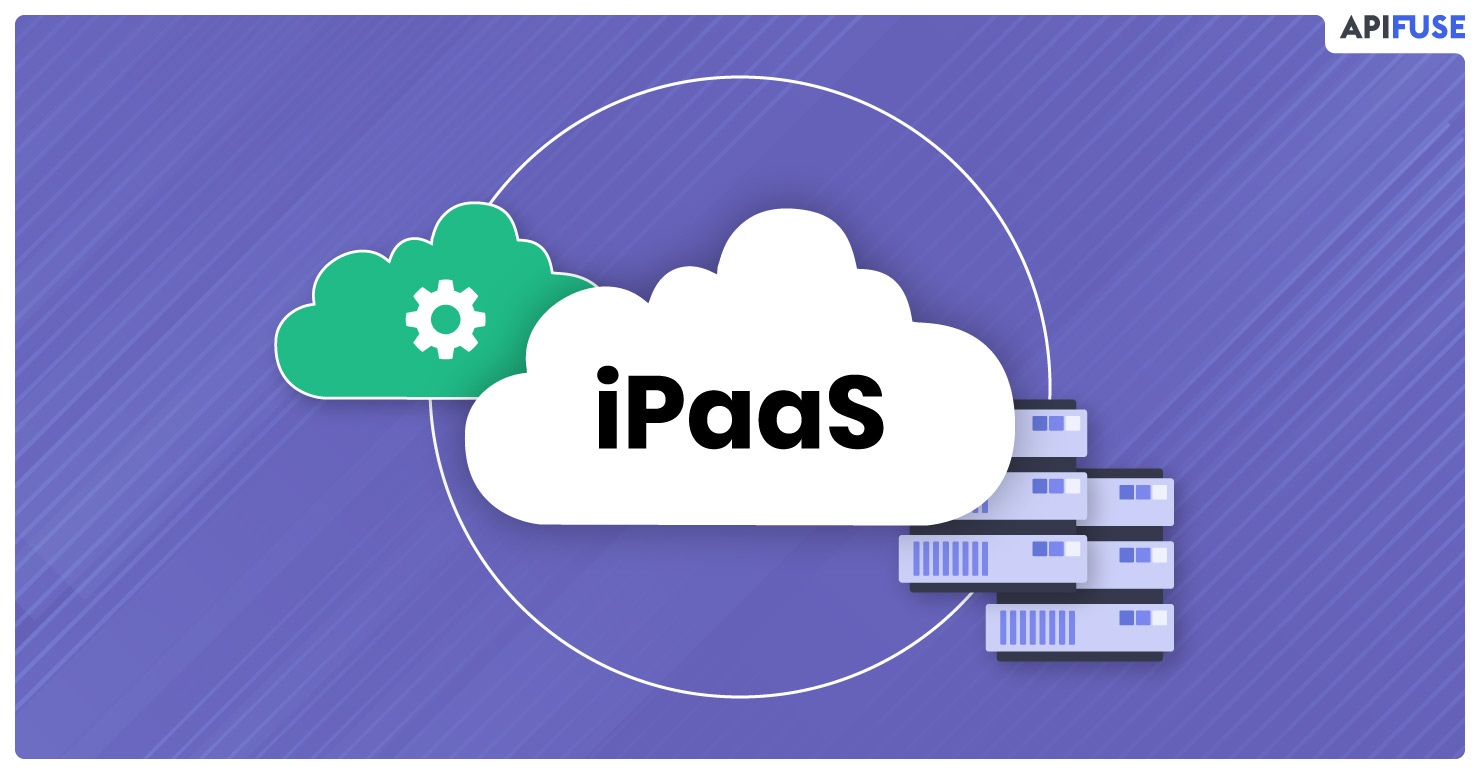
Integration Platform as a Service or iPaaS is an assortment of automated tools that link different applications working in different environments with little effort on your part. Also called cloud integration platforms, they also cater to AI management.
Built to host cloud integrations between SaaS applications and data sources, it is lightweight and horizontally scalable. iPaaS gets you up and running within minutes since it doesn’t have a learning curve. More than being prompt and easy to use, it doesn’t need heavy financial investment (something ESB demands).
These cloud services are ideal for any SaaS business that wants to automate workflows across various applications.
This is a very broad summary of iPaaS, to dig deeper into the basics, check out our uncut iPaaS guide.
ESB Vs. iPaaS: The 7 Differences That Set Them Apart
As we said before, the job ESB and iPaaS do may be the same, but how they do it is distinct. ESB was essentially built to be the communication center of on-premise systems. iPaaS was built to bridge cloud applications. However, it can now integrate both cloud and on-premise systems.
Another difference between ESB and iPaaS is security and compliance. iPaaS offers more governance as compared to ESB. The most significant distinction between the two is the coding requirement. iPaaS solutions like APIFuse leverage a no-code workflow builder and hundreds of pre-built connectors of widely adopted SaaS apps. You don’t need to invest time and effort in coding. The same is not possible with traditional ESB solutions.
1. System: On-Premise vs. Cloud
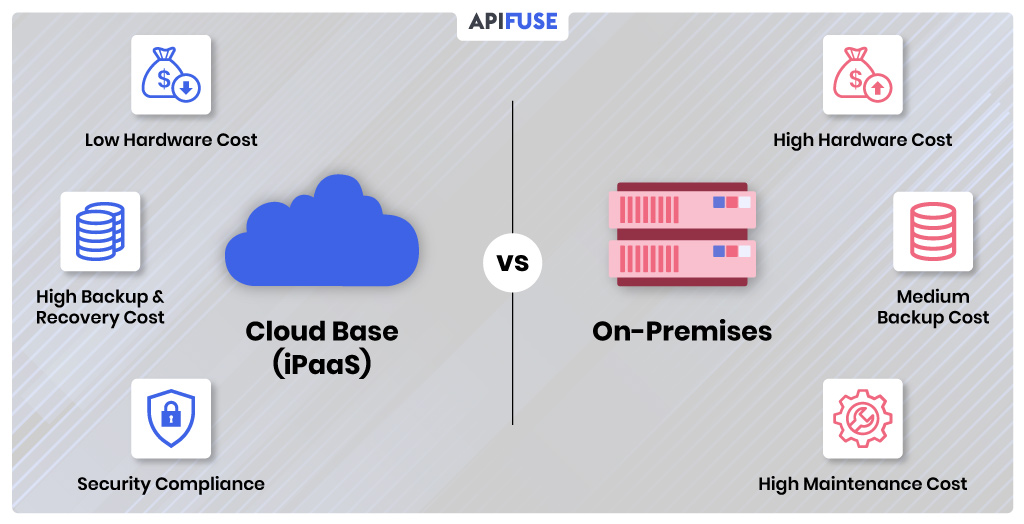
The most obvious contrast between ESB and iPaaS is the system type. ESB is an on-premises solution. It’s designed to be the middle layer between the cloud and local data/service. And because ESB cannot manage cloud integrations, many view it as a legacy technology.
iPaaS is cloud-based. It doesn’t require any software on your premises for it to work. Because it also eliminates the need for hardware, it is more agile and adaptable.
It’s worth noting that a few ESB solutions can integrate with cloud applications, but rarely is the connection viable. Inversely iPaaS can manage integration completely within the cloud or even a hybrid environment, i.e., cloud software and on-premises software.
2. Layer: Pass-through vs. Intermediate
In ESB, a message passes from the source to the destination. It doesn’t hold volumes of data at any time, making it stateless. Any transformation the messages undergo is minor.
iPaaS is akin to an intermediate layer that facilitates real-time data exchange. It can not only hold more data but also perform actions on it. With iPaaS, you can transform data as it moves from source to destination.
Moreover, iPaaS is exceptionally well-connected. It eliminates data silos and improves collaboration, a critical requirement for SaaS businesses.
3. Flexibility: Vertical vs. Horizontal
ESB offers vertical flexibility. You can integrate anything within the existing architecture of your on-site or internal systems. iPaaS, on the other hand, delivers horizontal flexibility. You can fluidly integrate anything – third party apps, partner systems, or ad hoc SaaS solutions, external or internal.
ESB can handle an increase in computing resources such as speed or power, or capacity. iPaaS can manage seamless connection capabilities.
iPaaS is also more scalable
Because their flexibilities differ, iPaaS and ESB have varying capacity to scale. With iPaaS solutions, you can integrate with as many applications as you need fairly quickly. This is possible because iPaaS has low latency, supports external integrations, and uses lightweight messaging standards like API and JSON.
With ESB, integrating to even a single new application can take months. Because it is slow and heavy, connecting to a network of systems and devices is near impossible. Given the speed with which application and data integration needs are changing for SaaS businesses, iPaaS is the obvious answer to scalability.
4. User: IT vs. Everyone
The user bases of ESB and iPaaS are at the opposite ends of the spectrum. ESB is run and managed by the IT department because it uses adaptors to link applications and systems. Adapters require coding and configuration, besides knowledge of data structures.
This introduces a high barrier to entry, chiefly if you are a startup and smaller business and can’t afford the technical staff to implement an ESB solution.
iPaaS can be used by anyone, from CTO to product manager to marketer to even HR. A user doesn’t need a technical background to integrate and onboard a new application because iPaaS utilizes integration libraries.
These require no-code, or in rare cases, low-code, making iPaaS friendly to non-IT users. So, while Enterprise Service Bus promotes stricter roles, iPaaS empowers everyone within and beyond your organization.
5. Ad hoc integrations: Slow vs. Fast
There was a time when adding new apps or software was only within the IT department’s realm. Today, every employee can request a software or app integration on an ad hoc basis. These require a quick turnaround, and ESB is too slow to handle them.
Ad hoc integration projects necessitate a lightweight solution, which iPaaS offers in abundance. The simplicity and real-time capabilities of iPaaS make ad hoc integrations possible and do it fast.
6. Data Governance: Fragile vs. Robust
Another major distinction between the two integration solutions is the ability to govern data. ESB has only a few governance features. Most iPaaS solutions come with robust and effective data governance features. This includes:
- Metadata management
- Data profiling
- Data quality mechanisms
iPaaS has more comprehensive governance features because it was designed to bridge data from multiple systems. Therefore, it took into accounting data modeling and schema.
7. Business: Small vs. Enterprise
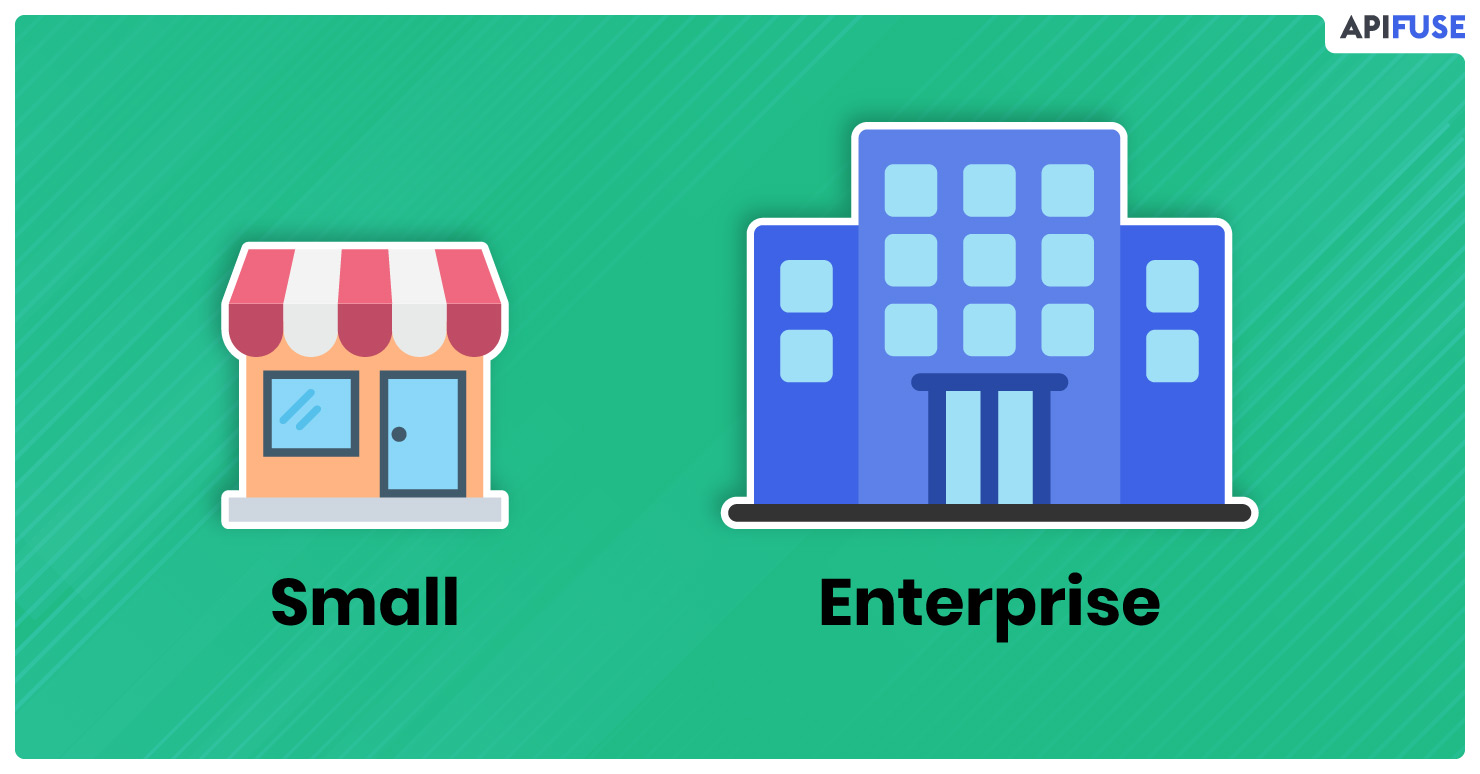
ESB is better equipped for large enterprises. If your business leverages centralized IT functions or has complex on-site content, it should be your choice.
For most integration needs, iPaaS is always the best solution. For smaller businesses, choosing ESB over iPaaS is overkill. It will burden your employees and eat a hefty chunk of your capital.
For anyone who wants greater integration capabilities or requires a connection with external SaaS solutions or data, iPaaS is the choice. The toolkit it offers makes managing integration effortless.
ESB Vs. iPaaS
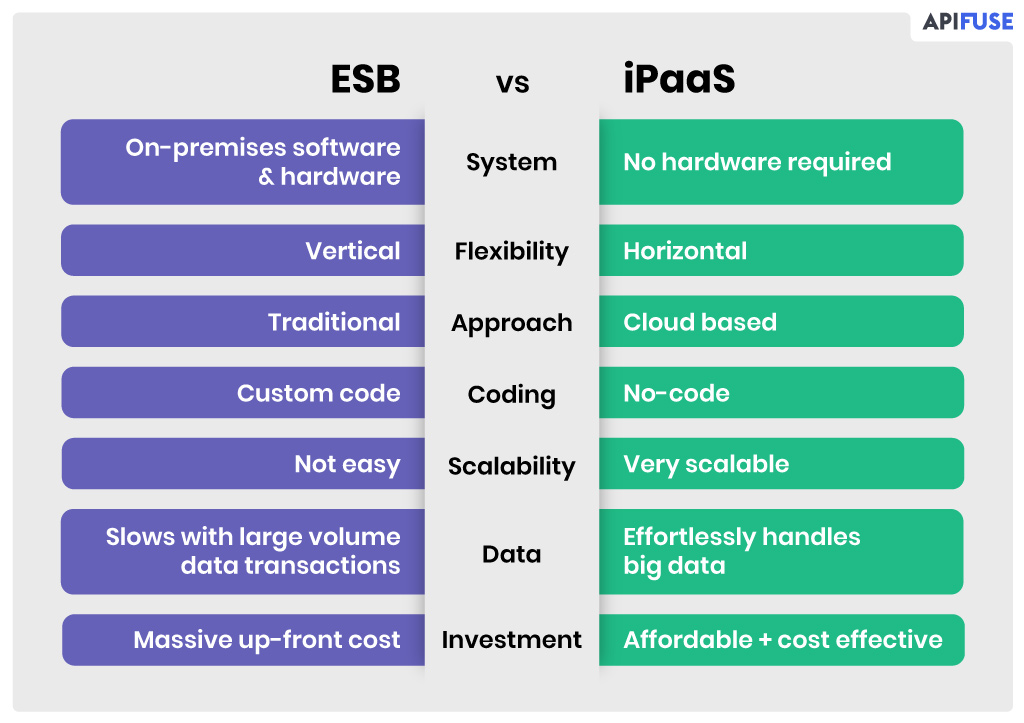
Why does iPaaS have the edge over ESB?
Comparing ESB vs. iPaaS makes it evident that cloud integration platforms are the obvious and smart choice for a modern SaaS business. But there is one difference that gives iPaaS a clear edge over traditional ESB architecture – multi-tenancy.
A multi-tenant solution has the capacity to allow several users to access the same software simultaneously. For instance, your marketing, sales, and operations department want to dig through your financial data. With a multi-tenant architecture, all the departments can access and use the information at the same time.
With ESB, this is not possible. It can’t host several users from a single software. iPaaS platforms can handle multitenancy with ease as it is cloud-native. Any number of users can retrieve, read, or examine data stored in any location in real-time. An ESB solution is just not built for this level of complexity.
There are additional benefits of multi-tenancy. It slashes the cost to the company. Both the system and maintenance expense for your customers is cut to a minimum because they can share the costs.
So, iPaaS gives you a solution that makes it easier to integrate any new connection to your current ecosystem. It empowers access to multiple users concurrently. And it does all this at an affordable cost.
Why should you choose iPaaS over ESB?
ESBs like IBM App Connect Enterprise or MuleSoft do help you build stable integrations. They can even become the backbone that holds your IT infrastructure up.
That said, if your product needs to integrate with:
- cloud-based applications
- mobile apps
- IoT devices
Then iPaaS is what you need. The ability of hybrid integration platforms to create connections in minutes without any coding is a distinct advantage. Not to say that they are far less expensive. iPaaS is also a compelling alternative to ESB because of:
- Ease of use
- Low or no skill level
- Quicker time-to-market
Conclusion
By 2022, the public cloud service market will expand to $331.2 Billion, or so Gartner predicts. For a SaaS business, this foretells a time when integration needs become an uphill challenge.
As the popularity of mobile apps and IoT rises, data touchpoints will increase exponentially, making data flow complex. Enterprise Service Bus, essentially a legacy and obsolete model, is not cut for it.
iPaaS, with its efficient and effective integrations, will step in to fill the gap. Savvy businesses are already seeing it happen. Cloud integration platforms are slowly replacing ESB. Soon they’ll be, but a chapter in history as more iPaaS vendors deliver integration flows with less stress.
API Fuse enables you to offer on-demand integration and to respond to end-users integration requests rapidly. With our solution and range of plans, you can provide users with native or custom integrations embedded directly into your SaaS app in minutes to accelerate your product roadmap and reduce technical debt. Request a demo today for more information!
